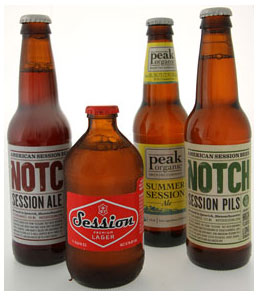
The idea behind session beers, say their advocates, is that they offer consumers the ability to drink multiple full-flavored beers without hitting the “tipping point” of intoxication. It’s an issue because many styles of craft beer have become more alcohol- and calorie-heavy as the category has grown.
Veteran beer maker Chris Lohring became so unhappy with the higher-alcohol movement that he started Notch Session as a response.
“I got out of the beer industry for a few years, and it was during that time that I realized I was unhappy with the beer selection and where the ABV’s (Alcohol By Volume) were gravitating towards,” he said.
Lohring, who started brewing commercially when he founded Tremont Brewing in 1993 (a business that he sold to Shipyard in 2004), has built an entirely new business model around creating beers that he describes as “less than standard.” All of his beers are under 4.5 percent ABV, with the newest offering, a Saison-style beer, checking in at just 3.8 percent ABV— well below the 5 percent ABV “standard drink” described by the U.S. Center for Disease Control.
But it’s not just passion for new flavor that is driving the session movement. The real sell from brewers is that it can help pump up the bottom line.
“This whole business model is done on inventory turns,” said Irene Firmat, the founder of Full Sail Brewing. “What retailers and distributors have at risk are floor space and cash flow. If you have a product that turns 12 times a year or more, you are generating that much more revenue for them off of their investment.”
Firmat liked the idea of “the beer session” so much that she trademarked the name for two of her beers. She said she believes that while special one-off beers and high-gravity offerings are nice, it’s session beer that is driving the most revenue growth for distributors and retailers.
“That is one of the things that as brewers we have to realize,” she said.” We are not in this business model by ourselves. We are in this business model to sustain our business partners all the way through.”
Nevertheless, there’s a fast-growing debate within the industry about the true alcohol content of a session beer. Style purists, for example, will argue that Full Sail’s Session Lager, which checks in at 5.1 percent ABV isn’t a truly a session offering. Historically, session beer (at least in Britain, where lower-alcohol beers are popular) checked in at 4 percent and lower. And the Brewers Association puts the number in a range between 4 and 5.1 percent.
For Firmat, however, it’s the intent behind the term “session” that’s most important, as it refers to the act of drinking multiple beers during a longer period of time.
“What we have always found engaging is the German saying ‘the first beer calls for the third,’” she said. “That is why we drink beer. It’s the sense of enjoying the beverage and you can have a few and still have a day ahead of you.”
Lohring, who distributes his beer exclusively in the state of Massachusetts, said the category is growing, and more on-premise accounts are looking for session offerings.
“The feedback I get from pubs and restaurants that have started to serve Notch is very positive,” said Lohring. “They (the customers) stay longer, they spend more money, they remember to leave a tip and they walk a straight line out of the door.”
Lew Bryson, a veteran beer writer, said he believes that the session trend is just now beginning to gain momentum.
“It’s really just the edge of the wedge,” he said. “It’s just now starting to pop.”
Bryson also echoed Lohring’s comments on sell-through.
“Session beers have a shorter shelf life, so they have to be sold faster,” he said. “They are also fairly high velocity sellers because a guy who wants to drink a Notch Pilsner is going to have three, not just one double IPA. Sipping on a 9 percent whopper for an hour is not a session and the bar is losing a seat.”
Despite all this, a vast majority of brewers have yet to adopt the session mentality. Ken Weaver, the former managing Editor of Ratebeer.com’s, The Hop Press, analyzed the sites database and found that the average ABV of new U.S. beers eclipsed 7 percent for the first time ever in 2009.
Lohring believes the consumers just need to be educated.
“I always talk about the myth of more flavor being wrapped around higher ABV -that has been emphasized for the last ten years,” said Lohring. “The consumer has gone along with that. Now that the consumer is seeing flavorful beer under 5 percent, they are beginning to pay attention to the category.”
Firmat believes that although somewhat new to the U.S. scene, the trend has staying power and distributors should be paying attention.
“I think the trend has way deeper legs now,” she said. “It’s going back to the roots of brewing. If you look at when we first started, these are the types of beers people were making.”
*This article will appear in the next issue of Beverage Spectrum Magazine
